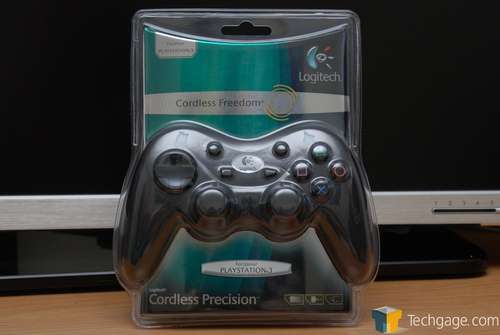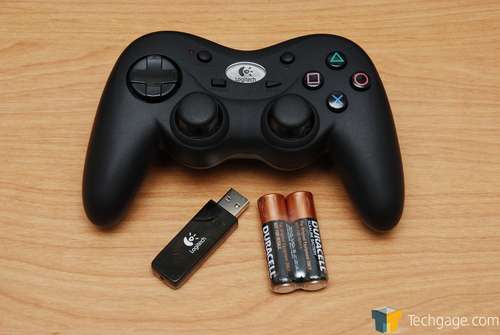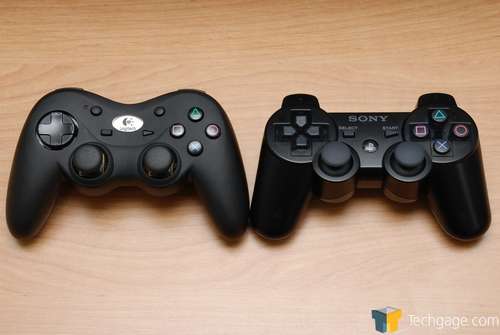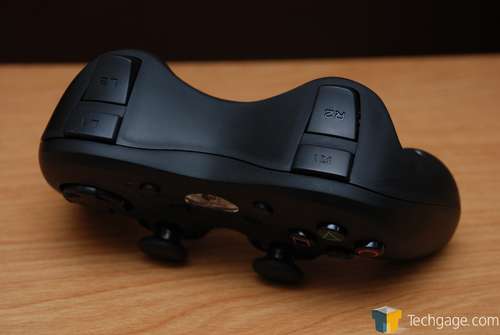- Qualcomm Launches Snapdragon 4 Gen 2 Mobile Platform
- AMD Launches Ryzen PRO 7000 Series Mobile & Desktop Platform
- Intel Launches Sleek Single-Slot Arc Pro A60 Workstation Graphics Card
- NVIDIA Announces Latest Ada Lovelace Additions: GeForce RTX 4060 Ti & RTX 4060
- Maxon Redshift With AMD Radeon GPU Rendering Support Now Available
PS3: Logitech Cordless Precision Controller

There’s a new PS3 wireless controller out there, and it’s from none other than the king of peripherals. Their controller costs $10 less than Sony’s own offering, but as we have found out, you might be better off spending that extra money.
|
|
For as long as there have been game consoles, there have been third party peripherals. This is a good thing. It offers choice, instead of the consumer being locked into whatever the console manufacturer offers. There are other benefits as well. Often, third-party products are far less expensive than the official ones. Sadly, that often amounts to a lesser product. There are a few exceptions to that rule, but they don’t come by often.
Logitech is no stranger to the third-party peripheral scheme of things. They have long produced quality gamepads, headsets and wheels for all of the popular consoles. What they seem to be even better at, though, is bringing console-equivalent gamepads to the PC. We have seen this both with the Rumblepad 2 and Chillstream gamepads.
The pad we are taking a look at today is for the Playstation3 and is direct competition to Sony’s own Sixaxis controller. While the official controller sells at retail for $49.99, Logitech’s alternative can be had for only $39.99. Do the savings outweigh the burdens? We’ll let you decide.
In typical Logitech fashion, the Cordless Freedom is packaged in a tightly sealed plastic blister pack. There are no perforated edges, so you will have to haul out a box cutter or scissors to tear the gamepad free. I’ve said it before, and I will say it again. Why are these packages necessary? For all the times I’ve avoided cutting myself on this type of packaging, I am sure someone out there has actually done it. It’s strange to call a piece of packaging dangerous, but it is.
Aside from the gamepad itself, you will also find two AA Duracell batteries and a wireless receiver. Here is where we find ourself in the middle of two rather large cons. First is the fact that the controller requires batteries. The good news in this is that Logitech promises close to 50 hours of playtime before they need to be changed. This is fine, however, the official controller never has to have a battery replaced. Instead, you plug it into the system while you are not using it (or when you are using it if you want a wired controller) while it charges.
I won’t discredit Logitech too much, because 50 hours is a long time. However, they are not a new player in the wireless market. All of their wireless mice have charging stations or proprietary rechargeable batteries that you can swap on a dime. So why doesn’t this controller have the same functionality? The Cordless Freedom could have easily gone the same route as the official controller, but they chose not to.
The second gripe I have is the fact that it uses a wireless receiver for the data transmission. I assume that this is thanks to Sony not allowing third-parties access to their proprietary wireless technology, similar to Microsoft, but does the receiver have to be that big? Sure, it’s small, but when plugged into the only available spot on your PS3, it will be quite noticeable.
On a good note, the gamepad is actually quite comfortable, though it’s larger than the official controller. Pick up your Sixaxis controller, and picture it slightly bulkier all-around. It’s not so large that it’s a burden to hold, but it’s definitely got some bulge compared to Sony’s light Sixaxis controller. After a few hours of gaming, I actually found myself preferring Logitech’s gamepad, because certain parts of my fingers were not too sore, like they get with the official controller. Depending on your hand size and how you hold the gamepad, your experiences may vary.
On the controller you will find the same amount of buttons as on the official offering, with the addition of the D-Mode, which allows you to switch control from the D-Pad to analog stick instantly. This is a nice touch, as the official gamepad forces you to push the PS button in order to change that.
To test the controller thoroughly, I played some Ridge Racer 7 and MotorStorm. It did not take long before I realized that I had to add another con to the list. All of the buttons on the gamepad are easy to push, no real tension behind them… except the L2 and R2 buttons. On the official controller, pushing those buttons is simple and doesn’t take much effort to push them down all the way.
However, there is a lot more tension with the L2 and R2 on this pad. At certain points during gameplay, I realized that I was not pushing the buttons down all the way for gas, so I was in turn not racing at full speed. This was more difficult to realize in MotorStorm due to the fact that there is no speed gauge. If you use your middle or ring finger to push those buttons, you may not experience this because of how your hand is positioned. If you, like me, use the index finger to push those buttons, then you will likely know what I am talking about.
Overall, the Cordless Freedom is not a terrible controller, but it could be better. The inclusion of a built-in rechargeable battery would have been nice, as well as a smaller receiver. There are a few other downsides that are not a huge deal, but should be mentioned. With this controller, you cannot check up on the battery status with the PS3. It will simply say, “-” for the charge status. Not surprisingly, pressing the PS button on this controller will not turn the console on, but you of course have the ability to turn it off since it’s menu based.
Yet another hit would be the lack of motion sensing. This is a feature I personally avoid anyway, but if you rely on it often, the gamepad is definitely not for you. Although the Cordless Freedom is a viable substitute to Sony’s own controller, it really brings nothing to the table and has more downsides than upsides. This is a big deal when it still costs $40. In future revisions, if there are any, I would love to see a built-in rechargeable battery, more loose L2 and R2 buttons and also a smaller USB receiver.
- Pros
- Comfortable, but bulkier
- Cheaper than Sixaxis controller
- Gamepad didn’t drop out once during gameplay
- D-Mode button is helpful for those who need it
- Cons
- Requires AA batteries (for 50 hours playtime)
- L2 and R2 buttons too stiff
- Cannot turn on the machine with PS button
- Cannot track battery usage
- Requires wireless USB receiver to work
- -Playstation 3-specific Limitations-
If you have a comment you wish to make on this review, feel free to head on into our forums! There is no need to register in order to reply to such threads.

|
|
Support our efforts! With ad revenue at an all-time low for written websites, we're relying more than ever on reader support to help us continue putting so much effort into this type of content. You can support us by becoming a Patron, or by using our Amazon shopping affiliate links listed through our articles. Thanks for your support!









